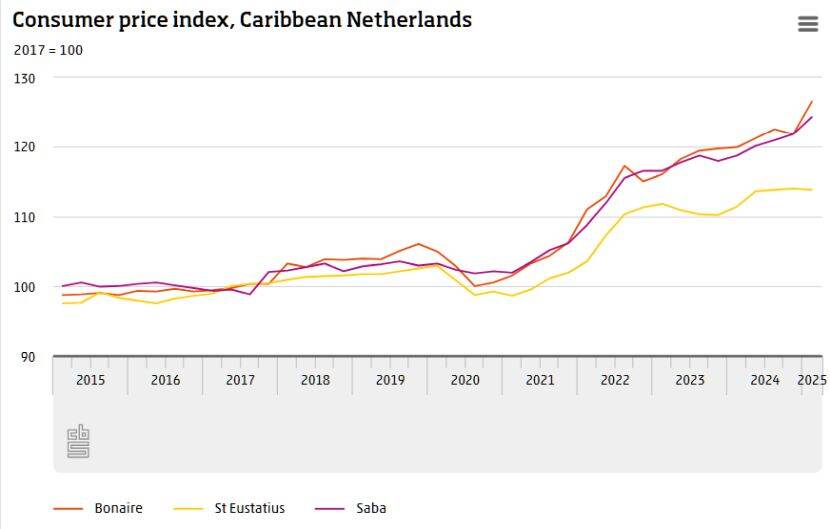Inflation up on Bonaire and Saba, down on St Eustatius
Consumer goods and services on Bonaire were 5.5 percent more expensive in Q1 2025, year on year. In the previous quarter (Q4 2024), inflation on Bonaire was 1.8 percent. This is reported by Statistics Netherlands (CBS) on the basis of the consumer price index for the Caribbean Netherlands.
On St Eustatius, prices were 2.2 percent higher in Q1 2025, year on year, compared with 3.4 percent higher in the previous quarter. Inflation on Saba was 4.8 percent in Q1 2025, year on year, compared with 3.3 percent in the previous quarter.

Prices on Bonaire 3.8 percent higher than previous quarter
Prices on Bonaire were 3.8 percent higher in Q1 2023 than they were in the previous quarter (Q4 2024). This increase was caused partly by rises in the cost of housing, water and energy. For example, water bills rose by 47.4 percent compared to Q4 2024 due to an increase in standing charges. Electricity prices also rose by 22.0 percent, as standing charges stopped being subsidised with effect from January 2025. Finally, prices for clothing and footwear also rose by 3.9 percent. This was mainly due to price increases for women's clothing and shoes.
On the other hand, prices for transport fell in Q1 2025 compared to Q4 2024. The price of petrol fell by 6.7 percent compared with the previous quarter, for instance, and the price of diesel fell by 7.0 percent.
Prices on St Eustatius 0.1 percent lower than in the previous quarter
On St Eustatius, consumer prices were 0.1 percent lower in Q1 2025 than they were in Q4 2024. Electricity became 3.8 percent cheaper, despite the discontinuation of part of the subsidy for standing charges on 1 January 2025. The fall in electricity prices was caused by a fall in prices on variable rates. Transport also became 4.7 percent cheaper, largely because flights became less expensive.
Water, meanwhile, was 34.8 percent more expensive than in the previous quarter. This was due to price increases in the variable rates for tap water. Water tanks also became more expensive. Prices for leisure and culture rose by 5.4 percent this quarter, mainly due to price increases for streaming services. Prices for clothing and footwear rose by 2.1 percent, mainly due to higher prices for women's clothing.
Prices on Saba up by 2.1 percent on previous quarter
In Saba, prices rose by 2.1 percent in Q1 2025 compared to the Q4 of 2024. Electricity became 36.0 percent more expensive due to the discontinuation of part of the subsidy for standing charges on 1 January 2025. Prices for clothing rose by 3.8 percent this quarter compared with the Q4 2024, and finally, health care costs also registered an increase of 4.4 percent. This was mainly due to higher prices for dental treatment.
On the other hand, prices for education and transport were down in Q1 2025. For example, petrol and diesel prices both fell by 4.7 percent, quarter on quarter.

Provisional figures
The figures pertaining to Q1 2025 are provisional and will only become definitive upon the publication of the figures on Q2 2025.
The provisional figures for Q4 2024 have been adjusted. For St Eustatius, this relates to the product groups of recreation and culture, and miscellaneous goods and services. For Saba, it relates to the product groups of housing, water and energy, and miscellaneous goods and services. These adjustments were made based on new data. In addition, in the case of Saba adjustments have been made in the index for accommodation and food services due to changes resulting from the final analysis and processing of data.
Papiamentu
A Papiamentu translation of this news release can be obtained from Statistics Netherlands’ office on Bonaire by sending a request by email to: caribischnederland@cbs.nl
Sources:
StatLine - Caribisch Nederland https://opendata.cbs.nl/CBS/nl/dataset/84046NED/table?dl=BFA9